
The Ponte Vecchio is a medieval stone closed-spandrel segmental arch bridge over the Arno, in Florence, Italy. The only bridge in Florence spared from destruction during World War II, it is noted for the shops built along it; building shops on such bridges was once a common practice. Butchers, tanners, and farmers initially occupied the shops; the present tenants are jewellers, art dealers, and souvenir sellers. The Ponte Vecchio's two neighbouring bridges are the Ponte Santa Trinita and the Ponte alle Grazie.
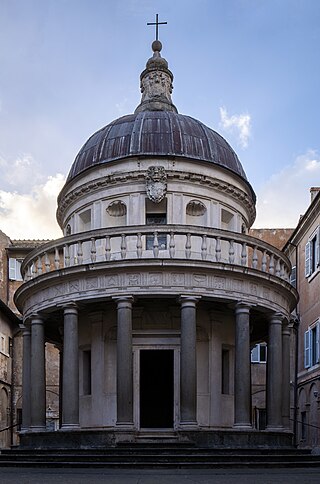
Renaissance architecture is the European architecture of the period between the early 15th and early 16th centuries in different regions, demonstrating a conscious revival and development of certain elements of ancient Greek and Roman thought and material culture. Stylistically, Renaissance architecture followed Gothic architecture and was succeeded by Baroque architecture and neoclassical architecture. Developed first in Florence, with Filippo Brunelleschi as one of its innovators, the Renaissance style quickly spread to other Italian cities. The style was carried to other parts of Europe at different dates and with varying degrees of impact.

Pulteney Bridge is a bridge over the River Avon in Bath, England. It was completed by 1774, and connected the city with the land of the Pulteney family which the family wished to develop. Designed by Robert Adam in a Palladian style, it is highly unusual in that it has shops built across its full span on both sides. It has been designated as a Grade I listed building.

The Strait of Messina Bridge is a planned 3.6-kilometre suspension bridge across the Strait of Messina, connecting Torre Faro in Sicily with Villa San Giovanni in the Italian Peninsula.
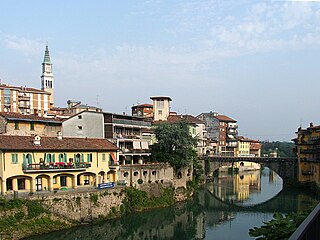
Ponte San Pietro is a comune in the province of Bergamo, Lombardy, northern Italy. It is about 40 kilometres (25 mi) northeast of Milan and about 7 kilometres (4 mi) west of Bergamo.

Palazzo Mozzi or Palazzo de' Mozzi is an early Renaissance palace, located at the end of the Piazza de' Mozzi that emerges from Ponte alle Grazie and leads straight to the palace where via San Niccolò becomes via de' Bardi in the Quartiere of Santo Spirito in the Oltrarno section of Florence, region of Tuscany, Italy. The 13th-century palace housed the gallery of the highly successful antiquarian Stefano Bardini, of which the remnants were left to the commune, where they assembled the Museo Bardini or Mozzi Bardini, displaying Florentine art and artifacts up to the early Renaissance. The gardens elaborated against the hillside behind the palace were added mainly by Bardini.

Ponte Amerigo Vespucci is a bridge over the Arno River in Florence, Italy and named after Florence-born explorer Amerigo Vespucci. It joins the Lungarno Amerigo Vespucci to the Lungarno Soderini. To the east is the Ponte alla Carraia.
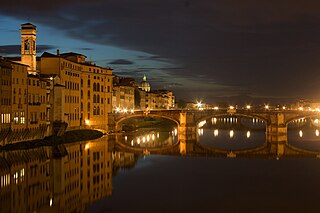
The Ponte Santa Trinita is a Renaissance bridge in Florence, Italy, spanning the Arno. The Ponte Santa Trìnita is the oldest elliptic arch bridge in the world, characterised by three flattened ellipses. The outside spans each measure 29 m (95 ft) with the centre span being 32 m (105 ft) in length. The two neighbouring bridges are the Ponte Vecchio, to the east, and the Ponte alla Carraia to the west.

The Bridge of Tiberius, historically also the Bridge of Augustus or the Bridge of Saint Julian, is a Roman bridge in Rimini, in the region of Emilia-Romagna, northern Italy.
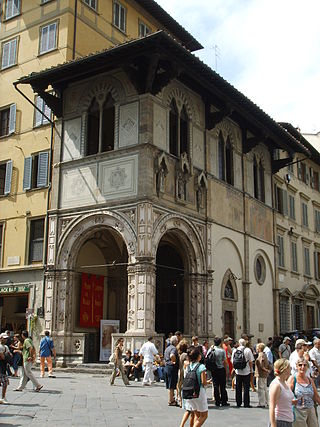
The Loggia del Bigallo is a late Gothic building in Florence, region of Tuscany, Italy. It stands at the corner of Piazza San Giovanni and via Calzaioli; tradition holds the site near the Baptistry of Florence was donated by a benefactor.

The Ponte alla Carraia is a five-arched bridge spanning the River Arno and linking the district of Oltrarno to the rest of the city of Florence, Italy. To the west is a weir, the Pescaia di Santa Rosa, and the Ponte Amerigo Vespucci, and to the east is the Ponte Santa Trinita. The piazzas on either bank are the Piazza Nazario Sauro (south) and the Piazza Carlo Goldoni (north). At the northernmost column of the bridge a family of coypus live in a dam.

The Ponte Salario, also called Ponte Salaro during the Middle Ages, is a road bridge in Rome, Italy, whose origins date back to the Roman period. In antiquity, it lay outside the city limits, 3 km north of the Porta Collina, at the point where the Via Salaria crossed the Aniene, a tributary of the Tiber. The visible side arches are assumed to originate from the first stone structure built during the 1st century BC.
Giovanni Battista Magnani was an Italian architect working entirely in Parma in the first half of the 17th century. He was the most successful of a family of masons and architects that included his father Nicostrato and his son Carlo.
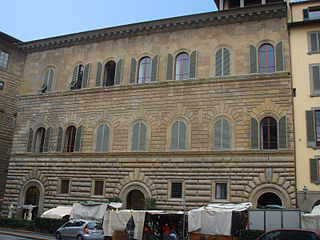
Palazzo Gondi is a palace in Florence, Italy, located a block from Piazza della Signoria. It was built in 1490 under design by Giuliano da Sangallo, who was inspired by other major works of stately buildings in the city, such as Palazzo Medici and Palazzo Strozzi. Among the elements borrowed from these earlier works are the cube-shape set around a central courtyard, the ashlar sloping on each of three floors, and the arched windows.

The Alberti family was a major political and noble family in Florence, allies of the Medicis, with trading agencies across Europe.
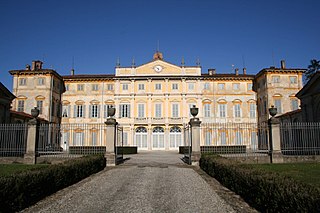
Villa Mapelli Mozzi, also known as Villa Mozzi or Villa Mapelli, is a large rural neoclassical-style palace in Locate Bergamasco, a frazione of Ponte San Pietro, which is located in the province of Bergamo, northern Italy.

The Palazzo Nasi, also known as the Palazzo Torrigiani or Palazzo Scarlatti, is a palace located at Piazza de' Mozzi 4, down the street where the Ponte alle Grazie enters the Oltrarno, in Florence, Tuscany, Italy. Another Palazzo Torrigiani Del Nero, with a Mannerist or late-Renaissance-style facade stands closer to the river. Both palaces also once belonged to the Nasi. The palace is a few steps from the Palazzo Mozzi.
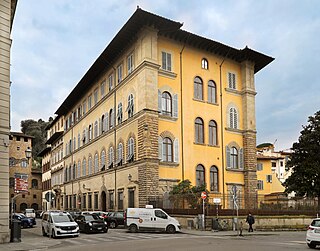
The Palazzo Torrigiani Del Nero is a Renaissance-style palace located at Piazza de' Mozzi 5, down the street where the Ponte alle Grazie enters the Oltrarno in Florence, Tuscany, Italy. Another Palazzo Torrigiani stands alongside, the smaller Palazzo Nasi. Both palaces also once belonged to the Nasi.

The Canal Grande is a navigable canal located in the heart of the Borgo Teresiano, in the very center of the city of Trieste, approximately halfway between the railway station and Piazza Unità d'Italia. The Canal Grande was a key element of the new urban plan that led to the construction of Borgo Teresiano.
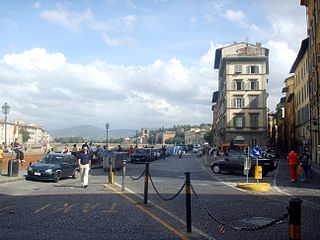
Lungarno Torrigiani is the stretch of the south bank of the Arno river in Florence that goes from Via de 'Bardi to the Ponte alle Grazie. From the Lungarno, there's an extraordinary view of the Uffizi, the Vasari Corridor and Ponte Vecchio.






















